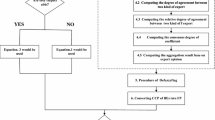Abstract
Fusion reactors like the International Thermonuclear Experimental Reactor (ITER) are generally complex systems, which demand reliability analysis. Common-Cause Failures (CCF) are increasingly important in the reliability analysis of these systems because of the widespread redundancy or similar components in them. However, despite the wide research in CCF, there has been little research on the handling of asymmetries of CCF that is inevitable in ITER. A concept of Multi-Common-Cause Failures (MCCF) and its key assumptions are discussed in this paper. On the basis of MCCF and the assumptions, a transition method named Common-Cause Breakdown Structure (CCBS) was designed to manage the asymmetrical CCF. The CCBS method can be easily applied to most fault tree analysis codes because the CCF treated by CCBS can be handled by traditional CCF models. A redundant system example was modeled and calculated in the reliability and probabilistic safety analysis program RiskA developed by FDS Team. The analysis results for water pumps redundant system applied in Tokamak cooling water system show that CCBS method is adequate and effective.



Similar content being viewed by others
References
J.N. Holtkamp, An overview of the ITER project. Fusion Eng. Des. 82, 427–434 (2007)
Y. Wu, Conceptual design and testing strategy of a dual functional lithium–lead test blanket module in ITER and EAST. Nucl. Fusion 47(11), 1533–1539 (2007)
A. Mosleh, K.N. Fleming, G.W. Parry, et al., Procedures for Treating Common Cause Failures in Safety and Reliability Studies, NUREG/CR-4780 (USNRC, Washington, DC, 1988) pp. 1–205
E.W. Hagen, Common-mode/common-cause failure: a review. Ann. Nucl. Energ. 7(9), 509–517 (1980)
K.N. Fleming, A. Mosleh, R.K. Deremer, A systematic procedure for incorporation of common cause events into risk and reliability models. Nucl. Eng. Des. 93, 245–273 (1986)
J.K. Vaurio, Extensions of the uncertainty quantification of common cause failure rates. Reliab. Eng. Syst. Saf. 78(1), 63–69 (2002)
A. Barros, A. Grall, D. Vasseur, Estimation of common cause failure parameters with periodic tests. Nucl. Eng. Des. 239(4), 761–768 (2009)
U. Berg, Reltree and risk spectrum—experience from and development of Psa Software for Pcs. Reliab. Eng. Syst. Saf. 30(1–3), 323–338 (1990)
Y. Wu, FDS. Team, Development of an integrated probabilistic safety assessment program. Chin. J. Nucl. Sci. Eng. 27, 270–276 (2007)
A. Mosleh, D.K. Rasmuson, F.M. Marshall, Guidelines on Modeling Common-Cause Failures in Probabilistic Risk Assessment, NUREG/CR-5485 (USNRC, Washington, DC, 1998), pp. 1–212
Y.G. Jo, Modeling and quantification of common cause failures among pumps with different operation histories, in Proc. Top. Meet. PSA (2005), pp. 1375–1382
D.I. Kang, M.J. Hwang, S.H. Han et al., Approximate formulas for treating asymmetrical common cause failure events. Nucl. Eng. Des. 239(2), 346–352 (2009)
D. Kancev, M. Cepin, A new method for explicit modelling of single failure event within different common cause failure groups. Reliab. Eng. Syst. Saf. 103, 84–93 (2012)
L. Xing, P. Boddu, Y. Sun et al., Reliability analysis of static and dynamic fault-tolerant systems subject to probabilistic common-cause failures. Proc. Inst. Mech. Eng. Part O: J. Risk Reliab. 224(1), 43–53 (2010)
C. Wang, L. Xing, G. Levitin, Explicit and implicit methods for probabilistic common-cause failure analysis. Reliab. Eng. Syst. Saf. 131, 175–184 (2014)
Y. Wu, FDS Team, Development of reliability and probabilistic safety assessment program riska. Ann. Nucl. Energ. 83, 316–321 (2015)
Y. Wu, FDS Team, CAD-based interface programs for fusion neutron transport simulation. Fusion Eng. Des. 84(7–11), 1987–1992 (2009)
L. Qiu, Y. Wu, B. Xiao et al., A low aspect ratio tokamak transmutation system. Nucl. Fusion 40, 629–633 (2000)
Y. Wu, J. Jiang, M. Wang et al., A fusion-driven subcritical system concept based on viable technologies. Nucl. Fusion 51(10), 532–542 (2011)
L. Hu, Y. Wu, Probabilistic safety assessment of the dual-cooled waste transmutation blanket for the FDS-I. Fusion Eng. Des. 81(8–14), 1403–1407 (2006)
Y. Wu, FDS Team, Conceptual design activities of FDS series fusion power plants in China. Fusion Eng. Des. 81(23–24), 2713–2718 (2006)
Y. Wu, FDS Team, Conceptual design of the China fusion power plant FDS-II. Fusion Eng. Des. 83(10–12), 1683–1689 (2008)
F.M. Marshall, D.M. Rasmuson, A. Mosleh, Common–Cause Failure Parameter Estimations, NUREG/CR-5497 (USNRC, Washington, DC, 1998), pp. 1–346
Acknowledgments
This work was supported by the Strategic Priority Research Program of Chinese Academy of Sciences (No. XDA03040000), the National Special Program for ITER (No. 2014GB112001, No. 2015GB116001), the Informatizational Special Projects of Chinese Academy of Sciences (No. XXH12504-1-09), and the Foundation of President of Hefei Institutes of Physical Science (No. YZJJ201327). The author would like to thank other members of FDS Team for their helps.
Author information
Authors and Affiliations
Corresponding author
Rights and permissions
About this article
Cite this article
Shanqi, C., Jin, W., Fang, W. et al. Asymmetrical Common-Cause Failures Analysis Method Applied in Fusion Reactors. J Fusion Energ 35, 221–228 (2016). https://doi.org/10.1007/s10894-015-0004-7
Published:
Issue Date:
DOI: https://doi.org/10.1007/s10894-015-0004-7




